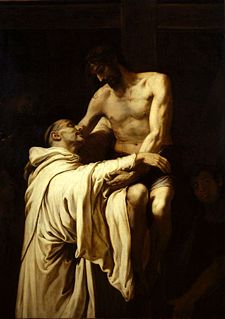
Francisco Ribalta
Encyclopedia

Spain
Spain , officially the Kingdom of Spain languages]] under the European Charter for Regional or Minority Languages. In each of these, Spain's official name is as follows:;;;;;;), is a country and member state of the European Union located in southwestern Europe on the Iberian Peninsula...
painter of the Baroque
Baroque
The Baroque is a period and the style that used exaggerated motion and clear, easily interpreted detail to produce drama, tension, exuberance, and grandeur in sculpture, painting, literature, dance, and music...
period, mostly of religious subjects.
He was born in Solsona
Solsona
Solsona can refer to:*Solsona, Lleida, a town in Catalonia, capital of the comarca of Solsonès;*Solsona, Ilocos Norte, a city in the Philippines...
, Lleida
Lleida
Lleida is a city in the west of Catalonia, Spain. It is the capital city of the province of Lleida, as well as the largest city in the province and it had 137,387 inhabitants , including the contiguous municipalities of Raimat and Sucs. The metro area has about 250,000 inhabitants...
. Although his first apprenticeship was apparently with Navarrete, who worked for years in the Escorial, Ribalta's earliest work (a Cruxifixion of 1582) was signed in Madrid
Madrid
Madrid is the capital and largest city of Spain. The population of the city is roughly 3.3 million and the entire population of the Madrid metropolitan area is calculated to be 6.271 million. It is the third largest city in the European Union, after London and Berlin, and its metropolitan...
. After his years in Madrid, Ribalta was to settle as an artist in Valencia. He became among the first followers in Spain of the austere tenebrist
Tenebrism
Tenebrism, from the Italian tenebroso , is a style of painting using very pronounced chiaroscuro, where there are violent contrasts of light and dark, and darkness becomes a dominating feature of the image...
style of Caravaggio
Caravaggio
Michelangelo Merisi da Caravaggio was an Italian artist active in Rome, Naples, Malta, and Sicily between 1593 and 1610. His paintings, which combine a realistic observation of the human state, both physical and emotional, with a dramatic use of lighting, had a formative influence on the Baroque...
. It is unclear if he directly visited either Rome
Rome
Rome is the capital of Italy and the country's largest and most populated city and comune, with over 2.7 million residents in . The city is located in the central-western portion of the Italian Peninsula, on the Tiber River within the Lazio region of Italy.Rome's history spans two and a half...
or Naples
Naples
Naples is a city in Southern Italy, situated on the country's west coast by the Gulf of Naples. Lying between two notable volcanic regions, Mount Vesuvius and the Phlegraean Fields, it is the capital of the region of Campania and of the province of Naples...
, where Caravaggio's style had many adherents. Alternatively, it is likely that tenebrist paintings were available in Spain by the early 17th century through the Spanish rule of the Neapolitan kingdom. Jusepe de Ribera is said to have been one of his pupils, although it is entirely possible that Ribera acquired his tenebrism when he moved to Italy.
The tenebrist style gathered a number of adherents in Spain, and was to influence the pre-eminent Baroque or Golden Age
Golden Age
The term Golden Age comes from Greek mythology and legend and refers to the first in a sequence of four or five Ages of Man, in which the Golden Age is first, followed in sequence, by the Silver, Bronze, and Iron Ages, and then the present, a period of decline...
Spanish painters, especially Zurbarán, but also Velázquez
Diego Velázquez
Diego Rodríguez de Silva y Velázquez was a Spanish painter who was the leading artist in the court of King Philip IV. He was an individualistic artist of the contemporary Baroque period, important as a portrait artist...
and Murillo
Bartolomé Estéban Murillo
Bartolomé Esteban Murillo was a Spanish Baroque painter. Although he is best known for his religious works, Murillo also produced a considerable number of paintings of contemporary women and children...
. Even the art of still life in Spain, the bodegón
Bodegón
The term bodega in Spanish can mean "pantry", "tavern", or "wine cellar". The derivative term bodegón is an augmentative that refers to a large bodega, usually in a derogatory fashion...
, was often painted in a similar stark and austere style. Among the direct disciples of Francisco were his son, Juan Ribalta
Juan Ribalta
Juan Ribalta was a Spanish painter of the Baroque period. He was born and died in Valencia. His father, Francisco Ribalta, was a famous painter, active in the style of Caravaggio. Juan's works and style are similar to that of his father....
, and Vicente Castelló. Ribalta died in Valencia on 14 January 1628.
Works
- CrucifixionCrucifixionCrucifixion is an ancient method of painful execution in which the condemned person is tied or nailed to a large wooden cross and left to hang until dead...
, his first work. - Some works in El EscorialEl EscorialThe Royal Seat of San Lorenzo de El Escorial is a historical residence of the king of Spain, in the town of San Lorenzo de El Escorial, about 45 kilometres northwest of the capital, Madrid, in Spain. It is one of the Spanish royal sites and functions as a monastery, royal palace, museum, and...
. - Martyrdom of St. Peter

